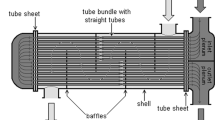Abstract
Heat exchangers are widely used in the process engineering such as the chemical industries, the petroleum industries, and the HVAC applications etc. An optimally designed heat exchanger cannot only help the optimization of the equipment size but also the reduction of the power consumption. In this paper, a new optimization approach called algorithms of changes (AOC) is proposed for design and optimization of the shell-tube heat exchanger. This new optimization technique is developed based on the concept of the book of changes (I Ching) which is one of the oldest Chinese classic texts. In AOC, the hexagram operations in I Ching are generalized to binary string case and an iterative process, which imitates the I Ching inference, is defined. Before applying the AOC to the heat exchanger design problem, the new optimization method is examined by the benchmark optimization problems such as the global optimization test functions and the travelling salesman problem (TSP). Based on the TSP results, the AOC is shown to be superior to the genetic algorithms (GA). The AOC is then used in the optimal design of heat exchanger. The shell inside diameter, tube outside diameter, and baffles spacing are treated as the design (or optimized) variables. The cost of the heat exchanger is arranged as the objective function. For the heat exchanger design problem, the results show that the AOC is comparable to the GA method. Both methods can find the optimal solution in a short period of time.
Similar content being viewed by others
References
HEWITT G F, SHIRES G L, Bott T R. Process heat transfer[M]. US: CRC Press, 1994.
HEWITT G F, HEWITT J. Heat exchanger design handbook[M]. New York: Begell House, 1998.
SINNOTT R K. Chemical engineering design (Coulson & Richardson’s chemical engineering series)[M]. US: Butterworth-Heinemann, 2005.
GOSSELIN L, TYE-GINGRAS M, MATHIEU-POTVIN F. Review of utilization of genetic algorithms in heat transfer problems[J]. International Journal of Heat and Mass Transfer, 2009, 52(9–10): 2 169–2 188.
GOLDBERG D E. Genetic algorithms in search, optimization, and machine learning[M]. US: Addison-Wesley, 1989.
CAPUTO A C, PELAGAGGE P M, SALINI P. Heat exchanger design based on the economic optimization[J]. Applied Thermal Engineering, 2008, 28(10): 1 151–1 159.
KAKAC S, SHAH R K, Aung W. Handbook of single-phase convective heat transfer[M]. New York: Wiley, 1987.
TAM L M, GHAJAR A J. Transitional heat transfer in plain horizontal tubes[J]. Heat Transfer Engineering, 2006, 27(5): 23–38.
KERN D Q. Process heat transfer[M]. New York: McGraw-Hill, 1950.
BELL K J. Final report of the co-operative research program on shell-and-tube heat exchangers[M]. Bulletin 5, Engineering Experimental Station, University of Delaware, Newark, 1963.
WILLS M J N, JOHNSTON D. A new and accurate hand calculation method for shell side pressure drop and flow distribution[C]//22nd Nat. Heat Transfer Conf., HTD. New York: Am. Soc. Mech. Eng., 36: 67–79.
PETERS D E, TIMMERHAUS K D. Plant design and economics for chemical engineers[M]. US: McGraw-Hill, 1991.
Global optimization test problems: Test Functions for Unconstrained Global Optimization[DB/OL]. HEDAR A, Kyoto: Kyoto University, 2009 [2010-3-2]. http://www-optima.amp.i.kyoto-u.ac.jp/member/student/hedar/Hedar_files/TestGO.htm.
TSPLIB: Symmetric traveling salesman problem[DB/OL]. REINELT G, Germany: University of Heidelberg, 2008 [2010-2-15]. http://comopt.ifi.uni-heidelberg.de/software/TSPLIB95/
LARRAÑAGA P, KUIJPERS C M H, MURGA R H, et al. Genetic algorithms for the travelling salesman problem: a review of representations and operators[J]. Artificial Intelligence Review, 1999, 13(2): 129–170.
Author information
Authors and Affiliations
Corresponding author
Additional information
This project is supported by Science and Technology Development Fund of Macao SAR (Grant No. 033/2008/A2), and Research Grant of University of Macau, China (Grant No. RG081/09-10S/TSC/FST)
TAM Houkuan is currently a PhD candidate at Department of Electromechanical Engineering, Faculty of Science and Technology, University of Macau, China. His research interests include heat transfer and applications of artificial intelligence.
TAM Lapmou is currently a full professor at Department of Electromechanical Engineering, Faculty of Science and Technology, University of Macau, China. He received his PhD degree in mechanical engineering from Oklahoma State University, USA, in 1995. He is also the President of Institute for the Development and Quality, Macau, China and senior member of Chinese Mechanical Engineering Society. His research interests include heat transfer, chaos, and energy saving.
TAM Sikchung is currently an associate professor at Department of Mathematics, Faculty of Science and Technology, University of Macau, China. He received his PhD degree in mathematics from University of Missouri-Columbia, USA, in 1993. His research interests include computational intelligence: neural networks, evolutional optimization, and applications of Mathematics.
CHIO Chouhei is an MSc candidate at Department of Mathematics, Faculty of Science and Technology, University of Macau, China. His research interest is evolutional optimization.
GHAJAR Afshin J is a regents professor and a director of graduate studies at School of Mechanical and Aerospace Engineering, Oklahoma State University, USA and a honorary professor at Xi’an Jiaotong University, Xi’an, China. He received his BS, MS, and PhD degrees, all in mechanical engineering from Oklahoma State University. His expertise is in experimental and computational heat transfer and fluid mechanics. Dr. GHAJAR has been a Summer Research Fellow at Wright Patterson AFB (Dayton, Ohio) and Dow Chemical Company (Freeport, Texas). He and his coworkers have published over 160 reviewed research papers. He has received several outstanding teaching/service awards. Dr. GHAJAR is a fellow of American Society of Mechanical Engineers (ASME), Heat Transfer Series Editor for Taylor & Francis / CRC Press and Editor-in-Chief of Heat Transfer Engineering. He is also the co-author of the 4th Edition of CENGEL and GHAJAR, Heat and Mass Transfer — Fundamentals and Applications, McGraw-Hill, Feb. 2010.
Rights and permissions
About this article
Cite this article
Tam, H., Tam, L., Tam, S. et al. New optimization method, the algorithms of changes, for heat exchanger design. Chin. J. Mech. Eng. 25, 55–62 (2012). https://doi.org/10.3901/CJME.2012.01.055
Received:
Revised:
Accepted:
Published:
Issue Date:
DOI: https://doi.org/10.3901/CJME.2012.01.055




